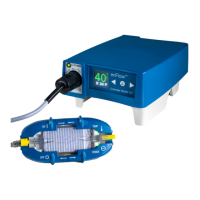- 19 of 40 -
4400-0024-EN Rev A
enFlow uid warming system temperature control and alarms
Temperature control
The enFlow IV uid/blood warming system includes multiple safety features to prevent overheating of infusion uids. There are built-in redundancies and
back-up safety systems as means for protection in the event of a failure in the primary control mechanism. Several aspects of the system work together to
accomplish desired and appropriate safety:
1. Closed-loop temperature control software
2. Audible and visual alarms
3. Software system monitor
4. Independent heater temperature monitoring circuit
Audible/Visual alarms
The enFlow system incorporates an audible/visual alarm system. This system monitors the uid temperature for an over-temperature condition and system
faults. The alarm function is tested each time a Cartridge is inserted. The audible alarm is briey sounded, and the red light emitting diode indicator is also
briey illuminated. If a dangerous condition occurs, a continuous audible and visual alarm is activated. Over-temperature conditions are calculated according
to ASTM Standard F2172-02 (an FDA recognized standard for uid warmers). This standard allows for spikes in the uid temperature without activating an
alarm. The alarm has a linear time-temperature relationship; therefore, the hotter the uid the less time it will take for the alarm to be activated. At 45 ºC
the alarm will sound after about 20 seconds while at 50 ºC it will be essentially instantaneous. The alarm will be activated by either the Warmer over-heating
the uid or if the uid entering the Warmer is too hot. The audible aspect of the alarm can be muted for 1 minute by pressing any key on the Controller. The
alarm can also be ended completely by sliding open the covers on the Warmer. (For further information, please reference test for Over-temperature Alarm
located in Appendix E: Preventive Maintenance Procedure.)
enFlow troubleshooting
Electromagnetic interference
• ECG, EEG or EMG (cardiac or neuro monitoring) artifact or other interference caused by the enFlow is an uncommon event.
• Cardiac or neuro monitoring interference is common and well-documented in medical literature.
• There are published suggestions to reduce or eliminate the interference that should be employed.
“Interference of the monitored or recorded electrocardiogram is common within operating room and intensive care unit environments.”
1
The enFlow
IV uid/blood warming system, as with all electrical devices, can be associated with some electromagnetic interference (EMI); however, it has been uncommon
and inconsistently experienced. Below are troubleshooting suggestions for situations where interference is observed:
Interference conrmation
Turn the unit o. Turn the power supply on the back of the Controller to the OFF position. Reassess the interference. Knowing that cardiac or neuro
monitoring is being aected, determine if the interference adversely aects your ability to care for the patient. Consider attempting to reduce the level of
interference by employing some simple and readily available solutions.
Interference reduction steps
Check the monitoring pads
All monitoring pads should be fully adhered to the patient’s properly prepared skin. Conrm that the pad’s foam insulator is not curled up, peeled back
or otherwise exposing the conductive gel layer. Conrm that the leadwires’ connectors are properly and fully attached. Consider reapplying monitoring
electrodes if there is any suspicion they have dried out.
Conrm the patient is properly grounded
In many cases, and in all cases using mono-polar or bi-phase cautery, a grounding pad should be present and applied according to the manufacturer’s
instructions. As previously suggested, conrm the ground pad is fully adhered to a properly prepared skin surface.
1
Patel, Santosh I., M.D., F.R.C.A. and Souter, Michael J, M.B., Ch.B., F.R.C.A.; Equipment-related Electrocardiographic Artifacts, Causes, Characteristics,
Consequences, and Correction; Anesthesiology 2008; 108:138–48.

